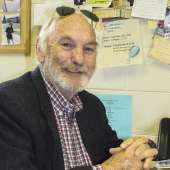Our faulty memories
It's been said that we are a story our brain tells itself. And our brains are habitual liars.
We feel like the most compelling thing we can tell someone else is that we know what we saw. And those who are experts on the functioning of the brain say no you don't. You have a distorted and constructed memory of a distorted and constructed perception, both of which are subservient to whatever narrative your brain is operating under.
This column contains two different narratives to bring to life what was said in paragraph one. Many of you may remember the McMartin Pre-School case from several years ago. Small children attending that pre-school testified in court that they were abused physically and sexually, that they were exposed to Satanic rituals, that they were forced to touch corpses and that there was a whole labyrinth of underground passageways under the school. It was perhaps the most shocking testimony ever given in a trial in this country because of the age of the witnesses. But none of these complaints could be confirmed. No hidden underground passageways were found, no dead bodies, human or otherwise were discovered, no physical evidence of physical or sexual abuse, etc. and, consequently, none of the employees of the pre-school who were charged with a variety of felony crimes were ever convicted of any of them. It was later surmised that child counselors, in interviewing the alleged victims, allegedly and perhaps unwittingly, coached the victims into making the claims that they did.
In another case that wasn't as famous but was just as significant, a robbery/murder occurred in Jacksonville, Florida. A documentary was made by HBO about this case and I showed it every year to my Criminal Justice classes at the college because of its significance. It was called 'Murder on a Sunday Morning' and it involved a white woman being robbed of her purse, then shot and killed by a young black male while her husband watched. An all-points bulletin was dispatched by the police with a detailed description of the shooter. While the investigation was going on at the scene of the crime, a young black guy who was walking by the scene was detained by police simply because he was a young black guy. He was placed in a police car and then the husband was brought over to take a look at him. The husband positively identified him as the shooter and he was immediately arrested, even though he didn't fit the description of the shooter at all.
Fortunately for him, he was assigned two top-not public defenders who after interviewing him, believed his story and set out to prove it. He said he was on the way to Blockbuster Video to apply for a job when the police detained him. After the husband of the victim made a positive I.D. he was then taken to the Jacksonville Sheriff's Department and interviewed by three different detectives.
During that time, he was threatened and assaulted which led to a forced confession. Because the detectives had an eyewitness identification and a confession, they did nothing else to prove their case. They didn't do a neighborhood canvass, they didn't interview the boy's parents, they didn't search the boy's house and room, they didn't find the gun used in the crime, and they lied over and over again on the witness stand.
The most dramatic part of the trial was when the victim's husband was called as a witness and was asked if the perpetrator of the crime was in the courtroom. He identified the defendant, saying he was positive he was the shooter and he would never send an innocent man to jail.
Because of the work done by the public defenders, sufficient reasonable doubt was established and the defendant was found not guilty. A few months later, the real shooter was arrested because his fingerprints were found on the victim's purse which had been recovered in a dumpster.
The husband didn't lie on purpose, although it seems everybody else involved in the case did. The husband thought he was telling the truth. His wife had been shot and killed in front of him less than an hour earlier and he believed with all his heart that the young man sitting in the back seat of a police car was the person who did it.
But he wasn't. The witnesses' memory was faulty and it caused him to make a false identification. The experts call this malleable memories combined with confirmation bias and an eyewitness identification in a court of law will get a defendant convicted faster than anything because of the jury's misperception that memories are exact and perfect. They're not, as this example proves once again, and because they're not, innocent people are convicted in courts of law across this country every day of the week.
Our memories are not perfect. They're not infallible and they're often wrong. Donald Trump has made claims of seeing thousands of Muslims celebrating 9/11 outside in New York City although no video of that celebration has ever been found. Did it happen or has he talked about it so often that he has come to believe it happened even when it didn't?
Just because someone says it's true doesn't make it true.

